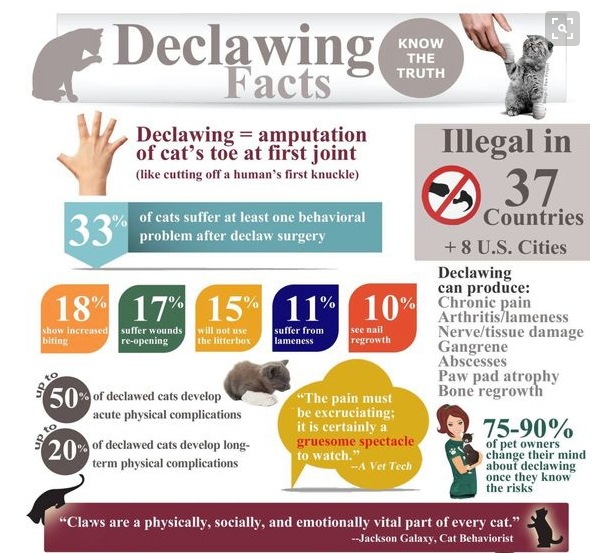Declawing cats has become a contentious issue, embroiled in debates concerning animal welfare, ethics, and legality. This procedure, which technically involves the amputation of the last bone of each toe, is often mischaracterized as a mere nail trimming. However, the implications for the feline population are profound, raising significant concerns within the sphere of animal rights law and public sentiment.
The legality of declawing varies significantly by region. In many places, particularly in the United States, declawing is still permissible despite the growing awareness of its detrimental effects on cats. Animal advocacy groups have been at the forefront of challenging this practice, citing that it is not only unnecessary but also inherently cruel. For those advocating for animal rights, the conversation centers around the belief that every creature deserves to experience life free from unnecessary pain and trauma.
To understand the legal landscape, one must examine the specific regulations in various jurisdictions. As of now, countries such as the United Kingdom and Australia have banned the procedure entirely, reflecting a progressive stance toward animal welfare. Some U.S. states and localities have enacted measures prohibiting declawing, thereby signaling a shift in societal attitudes. New York was the first state to implement such a ban at the state level in 2019, while cities like Los Angeles and San Francisco have enacted similar legislation. These moves are indicative of a broader trend recognizing the rights of animals and acknowledging the responsibilities of pet owners to ensure their well-being.
In stark contrast, in some states where declawing remains legal, practitioners argue that the procedure is justified under specific circumstances, primarily to prevent damage to furniture or for the relief of cat owners suffering from allergies. This rationale raises ethical questions about prioritizing human convenience over animal welfare. Critics emphasize that there are viable alternatives to declawing, including nail trimming, use of scratching posts, and behavioral training, which can effectively dissuade undesirable scratching without resorting to surgery.
Moreover, an examination of animal rights law reveals a unique landscape where the definitions of cruelty and welfare come into play. The American Veterinary Medical Association (AVMA) has expressed opposition to elective declawing, stating that it often leads to behavioral issues, including increased aggression or litter box aversion. Such post-operative complications highlight a clear disconnect between the perceived benefits of declawing and the actual outcomes for the cat. When discussing animal rights, it is essential to recognize that cats, like all animals, are sentient beings with the capacity to experience pain, fear, and distress. Their rights should be protected under the same legal frameworks that safeguard human welfare.
In the context of animal rights law, it is also vital to consider how societal attitudes toward pets have evolved over the decades. Cats are increasingly viewed not merely as possessions, but as integral members of the family. This shift necessitates a greater consideration of their needs and rights, framing declawing as an outdated, barbaric practice that belongs in a past era. Advocates argue that, in an age of growing understanding, declawing should be relegated to the annals of veterinary history. The case against declawing is strengthened by the emotional and psychological bond that cats share with their owners, reinforcing the notion that humane treatment should be paramount.
In addition, a comprehensive assessment of declawing visualizes it through the lens of animal welfare science. Studies have shown that declawed cats may exhibit increased fearfulness and can suffer from chronic pain due to the procedure. These findings highlight the stark reality that declawing is not a benign intervention but one that can compromise a cat’s quality of life significantly. Understanding the physical consequences of declawing further solidifies arguments against its legality and moral justification.
The ongoing discourse surrounding declawing requires an informed examination of the multifaceted nature of animal rights law. There is a pressing call to action for legal reforms that reflect changing societal values toward cats and pets in general. Advocates are pushing for wider awareness and education on the negative implications of declawing, seeking to galvanize public sentiment against this practice and ultimately influence legislation to reflect humane principles.
As discussions continue, pet owners are encouraged to reflect upon their responsibilities. The decision to declaw should not be made lightly, nor should it be viewed as a necessary evil. Instead, a conscientious approach to pet ownership emphasizes the importance of compassion, understanding, and respect for the needs of our feline companions. The rising tide of advocacy against declawing is rooted in the pursuit of a future where animal rights are considered paramount, ensuring that every cat has the chance to thrive without unnecessary suffering.
Ultimately, the future of declawing within the realm of animal rights law hangs in a delicate balance, dependent not only on legislative actions but also on changing cultural attitudes. As more communities recognize the intrinsic cruelty of declawing, the legal framework surrounding animal welfare will likely evolve, reflecting a more compassionate understanding of our responsibilities to all living beings. We stand at a crossroads, where the path we choose will undoubtedly shape the discourse on animal rights for generations to come.








